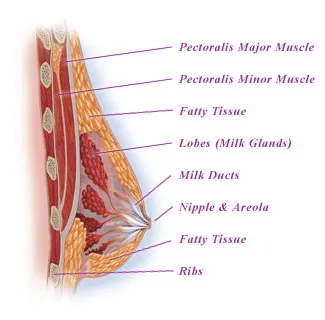Breast Anatomy

Breast Composition, Development and More
Women should become familiar with the anatomy and functions of their breasts so that they can spot any signs of possible abnormalities. Understanding the general anatomy of the breasts is also helpful to women considering breast implants who want to make an informed decision.
The breasts are parts of a female mammal's body that produce and secrete milk for the nourishment of their young. They are made up of a series of lobes and ducts that produce milk and carry it to the nipple. Fatty tissue surrounds the lobules and ducts and gives the breast its shape and soft feel. The breasts are supported and attached to the pectoralis muscles by ligaments and muscles.
Breast Composition

The breasts are composed of:
- Lobes (milk glands) — The lobes are the glandular part of breast where milk is produced. Each breast has 15 to 25 lobes which are arranged around the center of the breast like the petals of a daisy. Each lobe contains a number of smaller lobules, which end in tiny bulbs that produce milk during lactation.
- Milk ducts — Milk is carried from the lobules to the nipple by a network of ducts called the lactiferous ducts. These ducts widen at the base of the nipple to form sacs called the lactiferous sinuses, where milk accumulates.
- Nipple and areola — The milk ducts open at the nipple, from which milk is drawn, and the areola is the darker tissue that surrounds the nipple. The areola contains the Montgomery's glands, tiny glands that help to lubricate the areola which may appear as tiny bumps. The nipple and areola also contain muscle fibers that contract when stimulated and make the nipple erect.
- Fatty tissues — Fatty tissue make up the majority of the structural part of the breast. The fat surrounds the lobules and ducts that produce and deliver milk and makes the breast feel soft.
- Connective tissues — The breasts are supported on the body by muscles behind and underneath the breasts, and attached to the pectoral muscles by the Cooper's ligaments.
- Blood and lymph vessels — The breasts contains vessels that carry blood and lymph, which is a clear fluid that contains cells called lymphocytes that play an important role in fighting infections.
Development
Breasts begin to develop with the onset of hormonal changes associated with puberty, which usually occurs from 10 to 13 years of age. Development of the glandular breast tissue is associated with production of two hormones, estrogen and progesterone. Women should begin breast cancer screening at age 20.
Menstrual Cycle
Swelling of the breasts is common during the menstrual cycle due to changes in levels of the hormones estrogen, progesterone and prolactin in the body. During menustration, many women experience tenderness and the breasts may feel swollen or lumpy.
Pregnancy
Dramatic changes to the breasts occur during pregnancy as they prepare to produce milk for the infant. After conception, the breasts quickly increase in size, the areola and surrounding area become darker and the nipples become larger and more firm. The breasts usually begin producing milk a few days after the baby is born and continue until breastfeeding stops, though milk production may not completely cease for a several months.
Menopause
The breasts undergo changes when a woman reaches the age of menopause, typically in her late 40s or early 50s. Around this time, the glandular tissue of the breasts shrinks and is replaced by fatty tissue. Sagging can occur due to a loss of strength of the connective tissues that support the breast.
